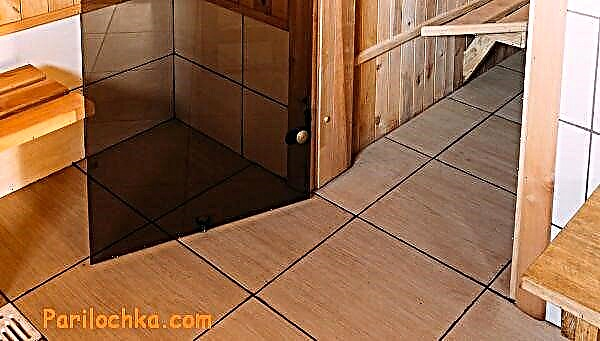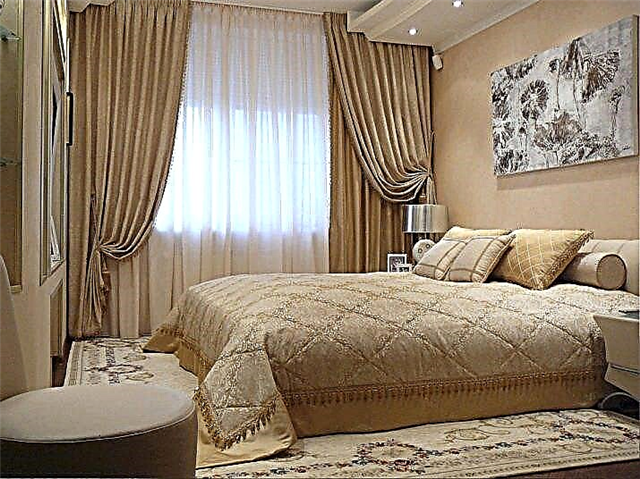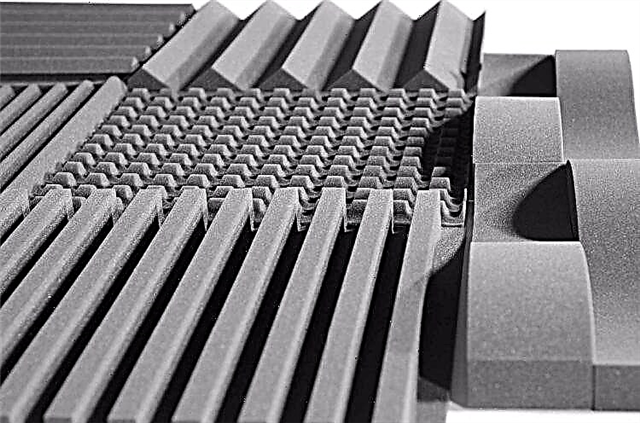How to choose an apron for a kitchen made of glass, the 6 most common mistakes when ordering and the nuances of installing glass panels, a price review, designer tips, photos of kitchens from the skin and reviews of glass aprons are here.
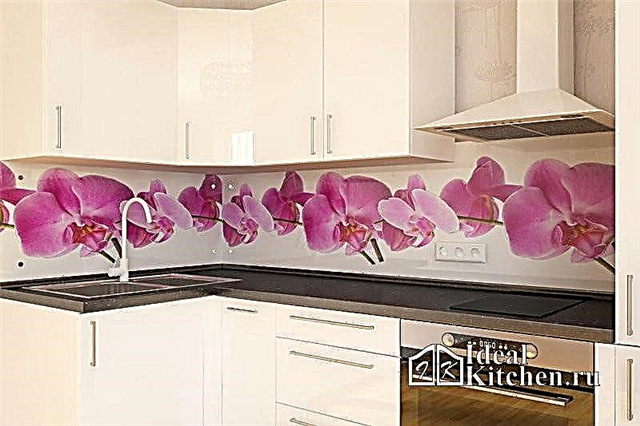
Glass is an excellent alternative to ceramic tiles and other materials that are traditionally used to finish an apron, that is, a section of the wall above the working area of the kitchen. This is one of the most environmentally friendly and hygienic finishing materials. The glass apron is not afraid of moisture and steam, does not absorb dirt and grease, is easy to clean and looks incredibly impressive.
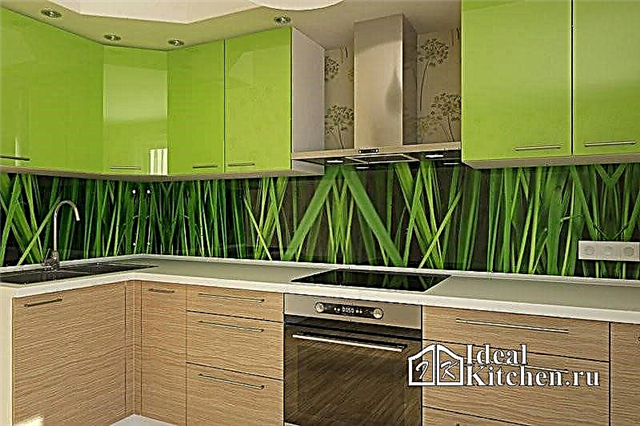
The most popular myth about glass aprons is that drops of water and grease, dust, fingerprints will be too noticeable on the shiny surface of the glass. However, according to reviews of those who have already decided to make such an apron in the kitchen, there are no more traces on it than on other surfaces, for example, on ceramic tiles. And it’s much easier to take care of it - the glass does not have tile joints, where pollution accumulates over time.
Which glass is suitable for an apron?
As a rule, the glass thickness for a kitchen apron is 6 or 8 millimeters.
In the working area of the kitchen, experts recommend using only tempered glass. First of all, for reasons of safety, durability and reliability.
Tempered glass is 5 times stronger than usual. But even if somehow it manages to break, its fragments will be small and not sharp.
Such an apron is perfectly adjacent to the stove or hob and is not afraid of heat.
Regular glass is less reliable. Plexiglas apron is generally difficult to consider as an option for wall decoration in the kitchen. It can not be used in the gas stove area due to temperature changes, plexiglass is easily scratched, tarnished, poorly cleaned of grease and other kitchen contaminants.
When choosing glass on an apron, keep in mind: you may need the so-called bleached glass - Optiwhite. Regular glass, although it seems completely transparent, actually has a pronounced greenish “bottle” tint. On colored aprons (with landscape, city panorama or multi-colored still life) it will be invisible. But if your apron has a lot of white or another very light background, the greenish tint will ruin everything. Experts note that, due to its greater transparency, Optivite makes the pattern on the apron more clear and bright. Lightened glass costs about 30% more than usual.
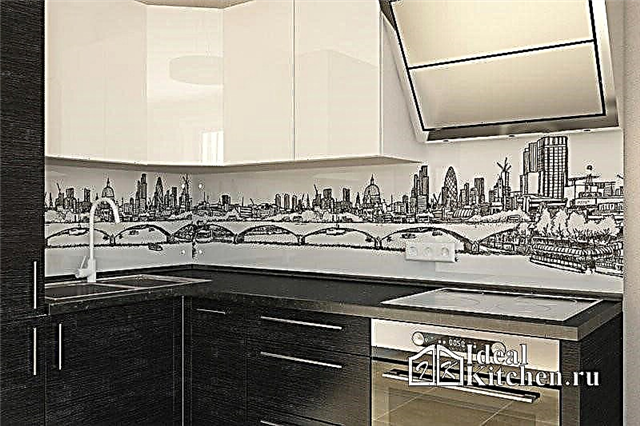
What could be a glass apron?
1. Colorless glass without color drawing
It can be transparent or frosted. The advantage of a transparent apron is that it is “invisible”, it does not catch the eye at all and seems to dissolve in space. Its main function is to protect the wall painted with paint or pasted with wallpaper (photo wallpaper) from splashes.
A frosted glass apron gives less glare and looks more interesting.
Glass does not have to be smooth at all. Panels with a textured textured surface, such as satin, look very nice.
Another option - with the help of sandblasting or silk-screen printing on the glass surface, you can apply a picture, ornament or inscriptions.
2. Photo printing (full color UV printing) on glass
The panels with a beautiful image applied to them were called skinned. Today it is the most popular and sought-after version of the apron made of glass.
The glass apron with photo printing is very beautiful and durable. The image is applied to the "wrong" side of the glass using special technology. UV ink does not fade, withstand heat up to 120 degrees, are not afraid of moisture.
Particularly impressive look panels with a 3D effect. However, such an apron will cost much more than colorless or stained glass.
3. Stained glass
The one-color colored glass apron looks very stylish, bright and at the same time unobtrusive. The palette of available shades without exaggeration is huge.
In the manufacture of such aprons, so-called stemalite can be used. A special paint is applied to the inner surface of the glass panel, then the glass is heat treated. This is a very reliable and durable method of staining.
4. With a pattern on a decorative vinyl film
A kitchen apron with vinyl film on which the drawing is applied is a more affordable and affordable option than photo printing. The film is rolled onto the inner surface of the glass, which protects it from moisture and temperature changes. However, over time, it can wrinkle, peel and burn out if the material and work were of poor quality.
5. Tempered glass triplex apron
Triplex is called laminated glass of different thicknesses. Its advantage is that the pattern is reliably protected from any external influences. The triplex apron is a “sandwich” of two layers of glass, between which the image is “baked”. If the triplex can be broken, it will not break, but simply covered with cracks. However, this option is rarely used in the kitchen. The reason is the relative high cost, its thickness is greater than that of a conventional glass apron, and there are some inconveniences with cutouts for sockets and roof rails.
6. Mirror apron
It looks very stylish and unusual, visually expands the space and creates an unusual visual effect. But many people are not very comfortable constantly seeing themselves in the mirror while cooking or washing dishes. Therefore, instead of a mirror panel, it is better to use a mirror tile with sandblasting and partial matting.
 According to your desire, any drawing or photograph can be applied to tempered glass, even from the family archive
According to your desire, any drawing or photograph can be applied to tempered glass, even from the family archive
Images for the skinhead

Our catalog contains over 6,000 skinheads and is easy to use. Search by keyword, topic or color is available. For most of the drawings, there are examples of finished glass aprons to understand how the image will look in a real kitchen.
Skinali can be tried on for free in the kitchen photo. If you liked the picture, but you live outside of Moscow, St. Petersburg or Nizhny Novgorod, then download the high-resolution image and buy an apron in the kitchen in your city.
Competition skinned
You have the opportunity to win a valuable prize in our competition. The winner is determined by our customers. The competition is held regularly, and many people have already received iPad mini from us as a pleasant addition to the beautiful skin. Participation in the competition is free. Order skins and get an iPad as a reward!
What are the advantages of a glass apron over ceramic tiles?
The main plus is a stylish look that will be in harmony with any design decision of kitchens in styles: hi-tech, neoclassic, art deco, modern, loft and other similar trends, up to eclecticism.

Nothing can be combined with chromed furniture legs, glass elements of household appliances, gloss of kitchen furniture in a minimalist style.
Of course, if your kitchen is decorated in a country style, classic or now popular Provence, then you should consider other solutions.
And for everyone else, glass is the best choice, not only because of the expensive and unusual appearance, but also because such panels are easier to wash.
There are almost no joints, any speck is immediately visible and wiping it will not be difficult. Indeed, you yourself know, if dirt is not visible, this does not mean at all that it is not!
Moreover, glass visually increases the space due to its luster and ability to reflect.
Also, it can be considered an advantage that it attaches to the wall very quickly, without any dirt and mass of cement mortar. Installation of the working wall takes only an hour or two, depending on the skill of the master and the original area.
It should be noted that a glass apron can be made so original that you will not find an analogue in any kitchen in the world.
You are free to choose any pattern for an apron that you like.
For example, insert a selection of family photographs under the glass or order photo printing according to a sample drawn by yourself.
So, to summarize the undoubted advantages of the skinal:
- Modern look
- The ability to maneuver in design
- Sterility
- Ease of attachment
What are the disadvantages?
And there are cons, of course. Where without them? Let's start with the main thing: if you have an uneven surface, then you cannot attach glass to it, it will burst.
This means not so much small irregularities in area, but skew in level, which is not always easy to level. But the tile can be well laid on any wall, adjusting the differences with the help of a solution.
Another apron made of glass is far from a budget option, except for polycarbonate subspecies. But they are not so durable. But we will consider this in the corresponding subheading.
It can also be considered a minus that a glass panel with an individual pattern needs to wait a long time. The manufacturing process may drag on for three weeks or more. And if you are impatient, then this option is not for you.
And so, there is nothing more to say as opposed to advantages.
For all other characteristics: impact resistance, heat resistance, etc., glass is in no way inferior to the standard tile coating. After all, this is not ordinary glass, which is completed with windows.
There are many subspecies and now we will consider them all in detail.
Materials for the manufacture of glass aprons
If you were looking for glass panels, you probably heard a lot of terms: skinal, enamel, plexiglass, optivite and other tricky names.
This is all a subspecies of the design and design of certain types of glasses. And you do not need to focus on them, because - this thing is already secondary. First you need to choose the material itself, and already start from it when choosing a subtype.
We will tell you everything in detail, and we will list these classes in certain types of glasses.
Stalinite - tempered glass
In a word, this is the most ordinary silicate glass, only tempered. Its strength is 10 times higher than that of ordinary, and even much higher than some types of ceramic tiles.
If, suddenly, you still manage to crush it, then such material is safe in terms of injuries and cuts: it scatters into small pieces, and its edges are not sharp, but rounded.
Such glass is not afraid of temperature changes, so that it can be safely installed next to a gas stove. It is not scratched and abrasive cleaning will not cause any damage to the surface. Such a coating serves as long as the usual tile - for decades.
But choosing this material, you need to remember one feature: after hardening and installation, you will no longer be able to drill a hole in it and put in a new outlet or some kind of hook. All holes are made in advance, before it is hardened. Then it just bursts from the punch.
Tempered glass has the following subspecies:
Stemalite or enamel (it is also reverse-painted or enameled glass) - it is first painted in the selected color, and then tempered.

As a result, the pattern becomes a single conglomerate with glass.
Skinal - tempered glass with a vinyl film backing, onto which the image is printed using photo printing or stereo printing. That is, you can well order a 3D drawing and your apron will be not just modern, but ultramodern.
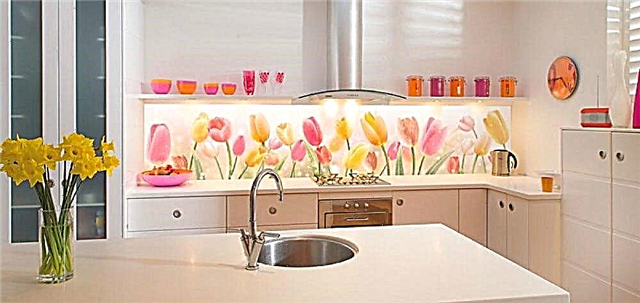
Optivite - perfectly clear, bleached glass. He does not have the slightest shade of greenish tone inherent in ordinary glasses.
If you are supposed to have a light pattern or some of the finest elements of an ornament on a substrate, then you need to dwell on this subspecies. Of course, it will cost more, but as a result you get a perfectly clear image.
The photo below shows the difference between a normal and a lightened coating:

But the visual difference is closer and in the context.
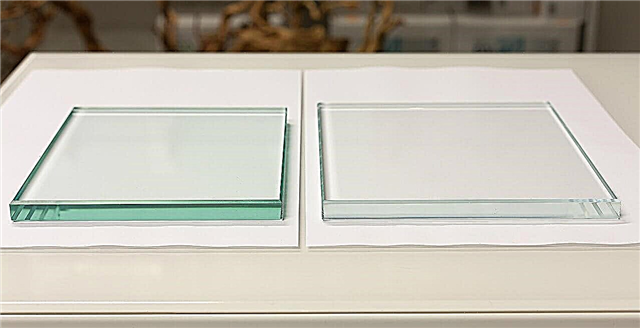
Satin - frosted glass. In care, it is more difficult, since the surface is rough. But it looks like velvet fabric.
Still there are glasses with built-in LED-backlight, with sandblasting ornaments. But this does not apply to the qualities of the material itself. The manufacturer will offer the design, and you will already choose what is more to your liking.
The main thing is not to chase cheapness and do not take glass 4 mm wide, this is not enough. The best option is 6 mm. Though more expensive, but more reliable and durable.
Triplex - laminated glass
The name itself suggests that it is a glass of three components. As a rule: two layers of glass, and inside some kind of picture on the film. At the same time, the base material itself can be any: ordinary silicate glass or the same stalinite.

Be sure to check with the manufacturer what their triplex is made of. The thickness of such panels for the kitchen is not less than 8 mm, which is good, it will be stronger. And upon impact, it does not crumble, but rests on the film with which the parts are glued together.
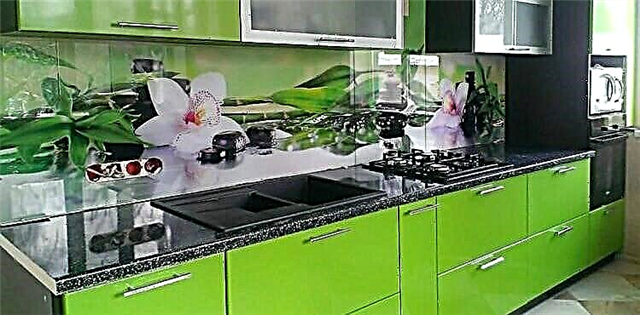
There is no guarantee that this view will not burst at all. It just does not crumble to the floor, but will look like glass, humbled by cracks. Still have to shoot. So whether it makes sense to overpay or not - it's up to you.
The only indisputable plus of such a coating is that condensation from the reverse side will not get on the picture, since it is also protected by glass. But here we can say this: just seal the joints well with silicone at the junction of the wall and the apron.
Triplex is much more expensive than ordinary tempered glass, not even because it is safer and more durable. Just thanks to the features of its production, go out a very wide range in the choice of design. You can order a mirror surface, and with a look of fabric, leather.
Plexiglass or Acrylic
This is the most affordable version of a glass apron. It is available, plus the ability to drill holes after installation, plus it is not necessary to have a perfectly flat surface on which you fasten the apron.

But this option is bad because it quickly loses sight. It can not be cleaned with abrasive powders, it instantly dims. And you still have to clean, the kitchen is the kitchen and you can’t always follow the greasy drops. Do not erase them on time, they harden. And how then to remove them?
In general, the option is cheap, but short-lived. Plexiglass also does not tolerate high temperatures, so it cannot be fastened nearby with the stove. And given the fact that the bulk of people have small-sized kitchens, where the stove is part of the working wall, this coating clearly falls out of the range of suitable ones.

Of course, at first it looks very personal. You can order and photo printing on it and other decorations. But, but ... Avaricious pays twice, as they say. If there is already a choice between plexiglass and ceramic tiles, then it is better to give preference to the latter.
Polycarbonate
About polycarbonate, you can say the same thing as about plexiglass. And plastic, and inexpensive, but quickly loses sight. The only plus before the last is that polycarbonate is more heat-resistant. This is where the virtues end.
In any case, no matter how good the plexiglass or polycarbonate initially looked, they still can not be compared to ordinary, tempered glass.
What patterns of glass aprons are more advantageous?
Since the surface of the working wall is not so vast, usually only 50 centimeters, we do not advise you to be too creative in choosing a drawing. Suppose that in such a compressed area motifs in the style of photo wallpaper look very poorly.
It is much better if you prefer either a plain coating or some kind of ornament. In this case, be sure to consider the color of your kitchen furniture.
If it is monophonic, then the wall can be made brighter.If on the contrary, then do not overload with flowers. Everything will merge and the view will come out not expensive, but simply tasteless.
And now let's look at specific examples of popular aprons made of glass in kitchen interiors.
Photo printing
There are a thousand options and one more. Anything you can order! Even applying your own self-portrait. There is no reason to talk a lot, it’s easier to see with your own eyes how it looks in the interior of the kitchen. We tried to choose the most winning combinations.
Harmoniously in the kitchen look images of fruits, vegetables, flowers.


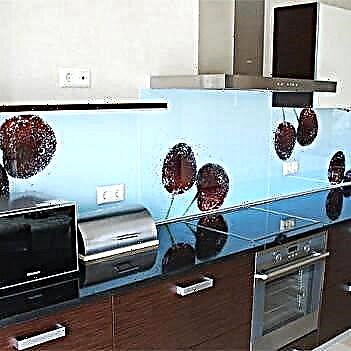
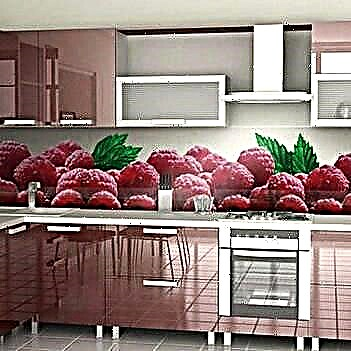





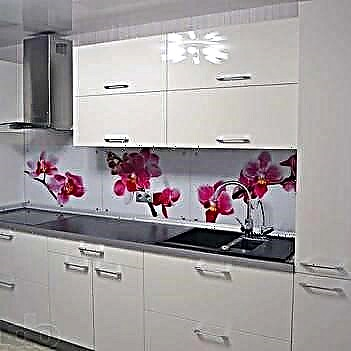
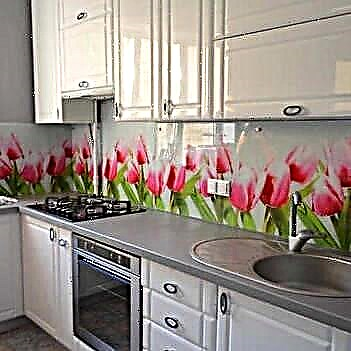

Prints with coffee motifs also fit perfectly.
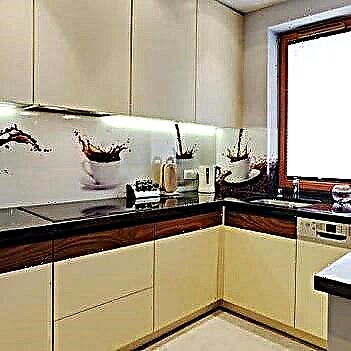



Someone like urban landscapes.
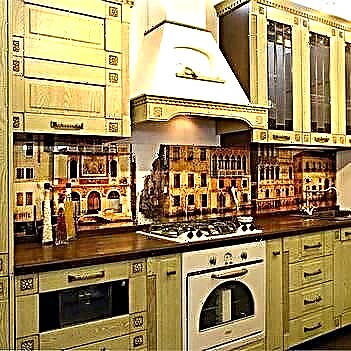




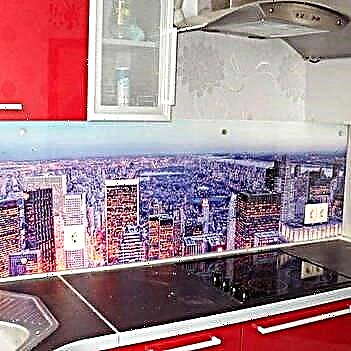
Prints with abstractions, classic monograms and floral ornaments may also look interesting.



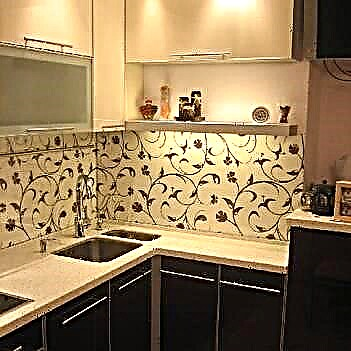





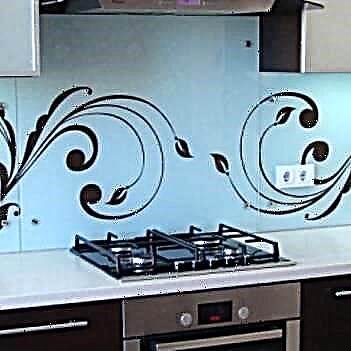
But, this is all in our subjective view. Maybe you will not like such options at all and you will pick up something completely opposite for yourself. Fortunately, the maneuver in choosing a picture here is simply dimensionless.
Solid glass apron
The glass painted in one tone looks noble and elegant. With one caveat: if it's real, tempered glass. Polycarbonate or plexiglass will have a sad look.
Look how well the color of the working apron is selected in this figure.

Such aprons, in the opinion of many designers, are the most universal. The main thing, as mentioned above, is to guess with color, its saturation and compatibility with the interior of the kitchen.








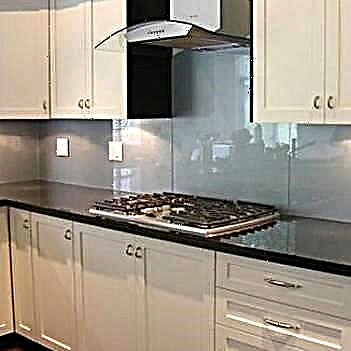

Mirrored and transparent
The mirror is good in that it significantly visually increases the space. If you are the owner of a small kitchenette, then you should consider this solution. Visually, the room will increase exactly twice, because the working apron will display the opposite wall.
The only negative of this design is that you will always have a feeling of someone's presence. Not everyone likes to endlessly observe their movements in the mirror.
Look at the picture below how such a surface looks “live”.

The mirror surface can be either solid or in the form of a mosaic.


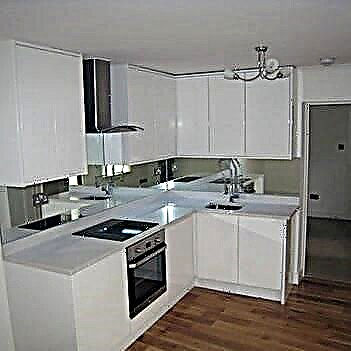

Using ordinary, transparent glass, you can simply cover the wallpaper or even masonry on the work surface. Which also looks good, while adding functionality.



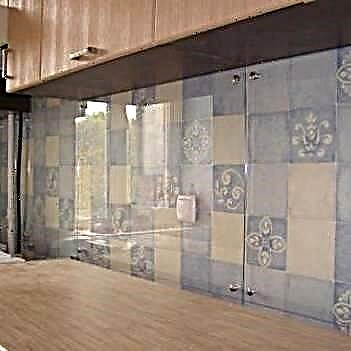
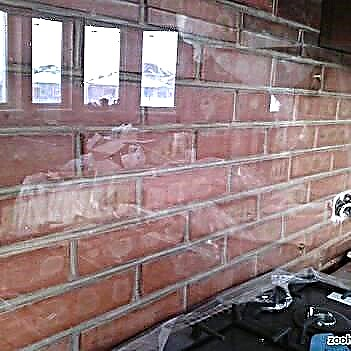



Types of fastening of glass panels
The glass apron for the kitchen is mounted either on “liquid nails”, that is, silicone, or on special mounts that are also suitable for mirrors.

The first option is much more preferable, since it is possible to make joints between the walls deaf, and this guarantees the durability of the picture and the chance to break such a panel becomes minimal.
On mounted or through fasteners, we do not advise you to do it.

Firstly, the attachment points will be visible, and secondly, a backlash is formed between the wall and the panel, which will collect condensation and dirt. But most importantly, such a panel is very shockproof. Due to its weight, it is much easier to break it than glued tightly.
How much is and where to buy?
An apron made of glass in the kitchen will help you choose the manufacturer's catalog, presented either in construction markets or on the Internet. Prices for glass aprons are calculated in square meters and range from 800 rubles to 5000 rubles per square, depending on the quality of the material.
In conclusion, I would like to say that we hope that the material presented here was useful. And after familiarizing yourself with it, you will choose the best apron made of glass for the kitchen, without overpaying at the same time, but without taking a one-day item.
Advantages and disadvantages
Glass is one of the most inert materials. It does not absorb odors, is resistant to chemicals, does not respond to humidity. Such characteristics are very well suited for use in the kitchen. Therefore, recently, glass panels for the kitchen are gaining more and more popularity.
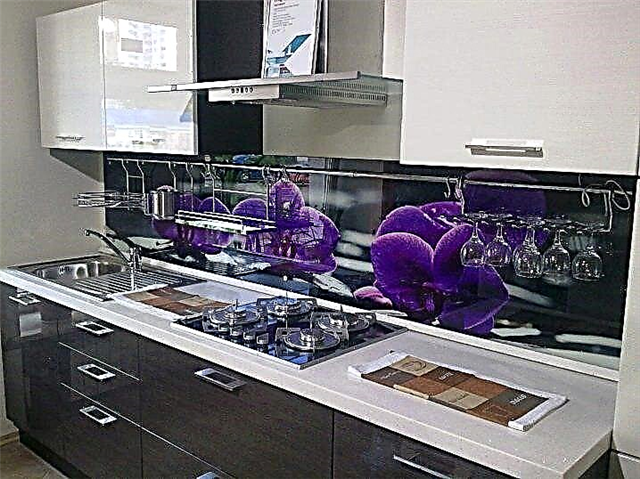
To do this, they have many advantages:
- Absolutely environmentally friendly all-natural material.
- All contaminants can be washed off with ordinary household products. But do not use hard brushes and washcloths to avoid scratches. Still, it is glass, not diamond.
- The glass panel is not afraid of the humidity of the kitchen, evaporation, odors.
- Such panels are made of solid glass sheet, which means there will be no butt joints, as in the case of tile panels. It is in these places that dirt often accumulates, and removing it from there is not an easy task.
- Glass is a non-combustible material. There is a risk of cracks on it from high temperature, but this does not threaten the occurrence of a fire.
- Glass panels can be made as absolutely transparent, and with a picture. Transparents are conveniently used exclusively as protective, if your interior is already thought out, you do not want to supplement it with anything, but you need to protect the walls from dirt.
- Skinal can have different colors, glossy or matte, with many options for drawings. Variety makes it possible to harmonize the interior of the kitchen with their help, to add additional accents to it.
- Typically, these wall-mounted aprons are mounted on screws, leaving a small gap between the panel and the wall surface. So you can do without a thorough preparation of the wall, its flaws will be hidden by the panel.
- The installation of panels itself is possible in a short time and is not associated with inconveniences, as in the case of laying ceramic tiles.
- Durability. Made of tempered glass, heat-resistant panels do not deform, paints do not fade, so their service life will be determined only by your desire to replace them.
Having considered the advantages, it is impossible not to mention the disadvantages:
- Skinali is recommended to be installed only after full placement and suspension of furniture. The dimensions for manufacturing must fully correspond to the distance between the countertop and the bottom of the wall cabinet. All necessary openings must be considered. This must be done especially carefully, because it will not work. Will have to change completely.
- The cost of such a kitchen apron is quite high. Installing it yourself is impractical. The process requires professional skills, caution, because you have to work with glass.
- We can definitely say that the existing shortcomings cannot outweigh the advantages and the choice of glass panels in the kitchen will be a reasonable and reasonable decision.

